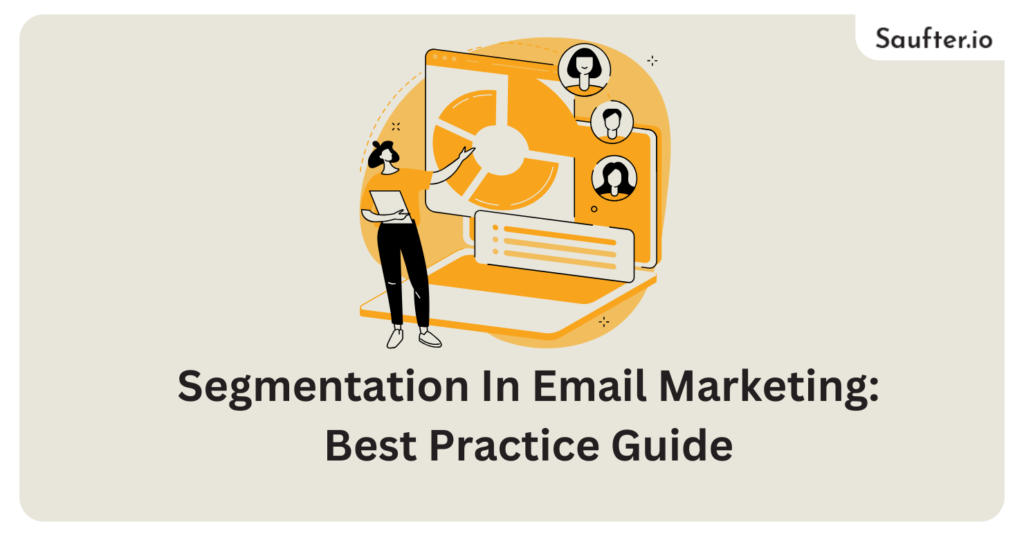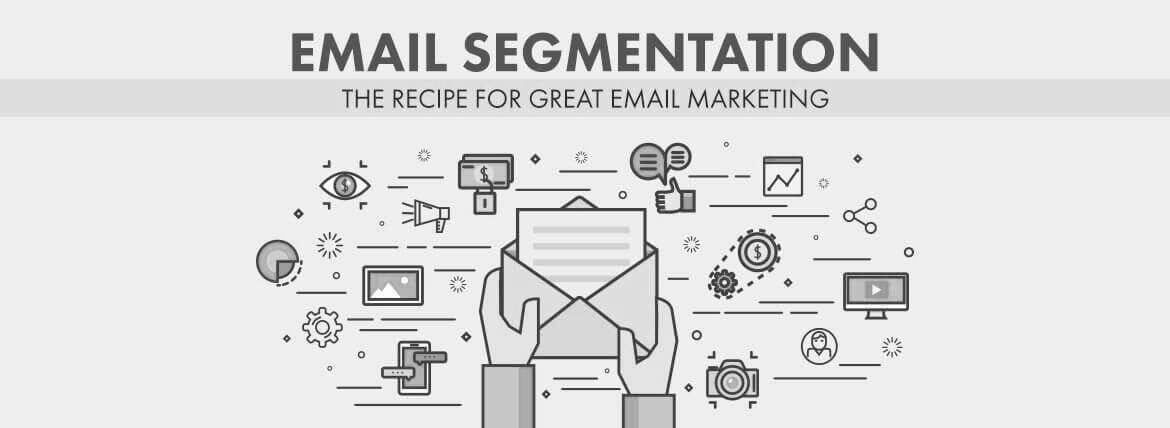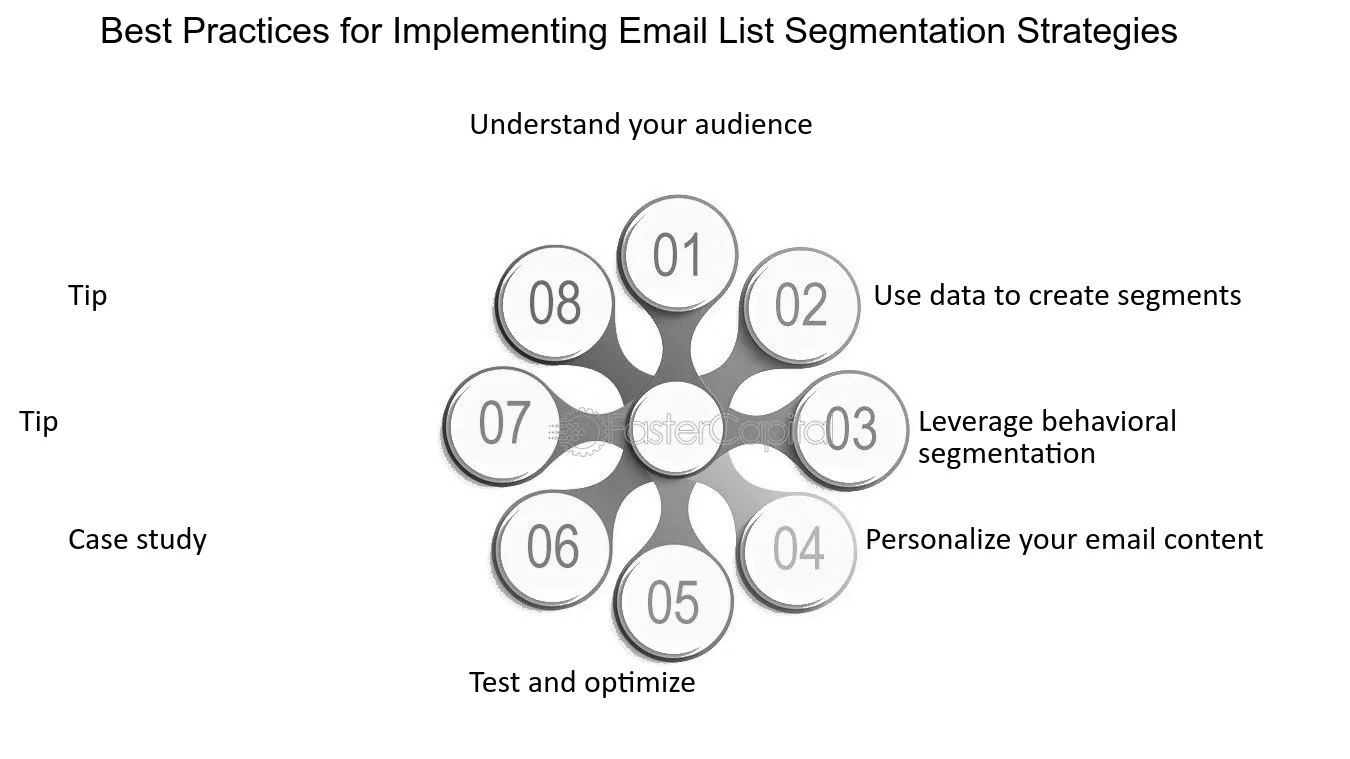Last Updated: December 2025
Email marketing continues to dominate the digital marketing landscape, boasting an impressive average ROI. However, the key to unlocking this potential lies in delivering the right message to the right audience. This is where segmentation in email marketing becomes a game-changer.
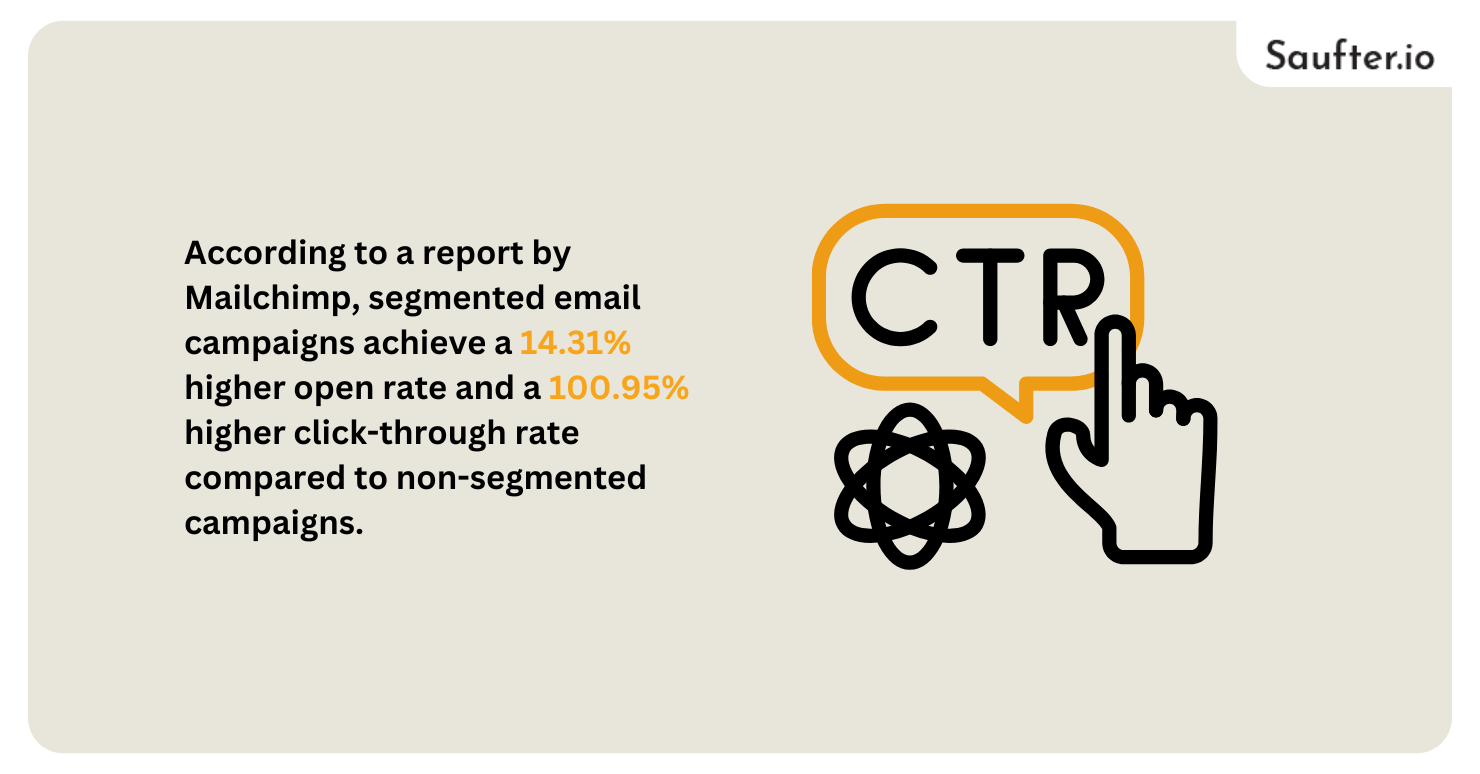
According to a report by Mailchimp, segmented email campaigns achieve a 14.31% higher open rate and a 100.95% higher click-through rate compared to non-segmented campaigns. Additionally, 77% of email marketing ROI comes from segmented, targeted, and triggered campaigns. These statistics underscore the undeniable power of segmentation in email marketing in driving engagement, conversions, and customer loyalty.
In this comprehensive guide, we’ll dive deep into the best practices, strategies, and tools for segmentation in email marketing, equipping you with the knowledge to create highly personalized and effective campaigns.
What is Email Segmentation?
Email list segmentation is the process of dividing your mailing list into more targeted groups based on various criteria. The criteria that could be taken into account are demographic, geographical location, behavior, interest, purchase history, and so on. From this, you proceed to create campaigns for these segments to address their needs and preferences by developing messaging that grounds the needs of each group to get more relevant engagement.
For example, a fitness brand may segment its audience based on the following groups: yoga lovers, weight lifters, and runners, sending yoga tutorials to the former, lifting tips to the latter, and some gear recommendations for running. Such a level of personalization not only caters to enhancing the experiences of recipients but will also aid in increasing the chances for engagement and conversion.
Why is Segmentation in Email Marketing Important?
In today’s digital landscape, consumers are inundated with emails. The average office worker receives 121 emails per day, making it crucial for businesses to stand out in crowded inboxes. Generic, one-size-fits-all emails are no longer effective.
Segmentation in email marketing allows businesses to cut through the noise by delivering personalized, relevant content. According to HubSpot, marketers who use segmented campaigns note a 760% increase in revenue. This underscores the importance of tailoring your email strategy to meet the unique needs of your audience.
Moreover, segmentation helps build stronger customer relationships. When subscribers receive content that aligns with their interests and behaviors, they are more likely to trust your brand and remain loyal.
Key Benefits of Email Segmentation
Improved Engagement
Personalized emails tend to have a positive impact on recipients, which in turn reflects in the higher open and click-through rates. A study by Experian has shown that personalized emails generate six times higher transaction rates. In other words, if you can relate to the specific needs and interests of the recipient, you are more likely to earn their attention and prompt them to take action.
Fewer Unsubscribe Rates
Relevant content lowers the risk of them wanting to opt out of future communications. No one wishes to get emails that do not meet their interests. By segmenting them and addressing the target audience, you can be able to cut open rates and retain more of them.
High Rates of Conversion
Message targeting is by far better for recipient communication, which greatly optimizes chances for that transaction. An e-commerce company suggesting other products based on someone’s prior purchase has more chances of selling. According to DMA, segmented campaigns yield a conversion rate much higher by 50% when compared with mixed campaigns.
Increased Customer Loyalty
Once subscribers receive content preferred and tailored to them, a strong feeling of warmth sets in; they feel valued and attached to the brand’s long-lasting loyalty for repeat business.
Effective Segmentation Strategies
Demographic Segmentation
Demographic segmentation refers to the categorization of consumers based on various environmental circumstances, including age, sex, income, education level, and occupation. For instance, luxury marketers might want to market their elite events to high-income earners; in contrast, a low-budget brand could market their products to those in the 18 to 24 age bracket.
Example: A skincare brand could segment its audience by age, sending anti-aging product recommendations to older subscribers and acne solutions to younger ones.
Geographic Segmentation
Location-based segmentation is when a group divides individuals into different sections based on their geographical location to offer a specific promotion or information. A retail chain could, for example, inform its clients about in-store events or offer them product recommendations relevant to the current weather.
Example: A coffee chain might send emails promoting iced drinks to subscribers in warmer climates and hot beverages to those in colder regions.
Behavioral Segmentation
Behavioral segmentation, a type of segmentation, focuses on consumer behavior such as past purchases, website visits, and emails opened. An example would be an online store sending a special discount to customers who have abandoned their carts to get them to convert into a purchase.
Example: A streaming service could segment its audience based on viewing habits, recommending similar shows or movies to subscribers who frequently watch a specific genre.
Psychographic Segmentation
This is a technique based on the lifestyle, values, and interests of the subscribers. A travel agency might divide its audience into categories like adventure seekers, luxury travelers, and budget families, then communicate with each category of travelers based on their nature.
Example: A fitness brand could send motivational content to subscribers who value health and wellness while offering discounts on premium products to those who prioritize luxury.
Also Read- 15 Best Digital Marketing Agencies in Canada
Best Practices for Implementing Email Segmentation
Collect Relevant Data
Start by gathering comprehensive data during sign-up and through ongoing interactions. Use sign-up forms, surveys, and tracking tools to collect information such as preferences, purchase history, and engagement behavior.
Tip: Offer incentives, such as discounts or free resources, to encourage subscribers to provide detailed information.
Maintain Data Accuracy
Regularly update and clean your email list to ensure the information used for segmentation remains current. Remove inactive subscribers and update any changed information.
Tip: Use email verification tools to identify and remove invalid email addresses.
Test and Optimize
Continuously perform A/B testing on segmented campaigns to identify what resonates best with each group. Test different subject lines, content, and calls to action to refine your approach.
Tip: Test one variable at a time to accurately measure its impact on performance.
Monitor Performance Metrics
Track key metrics such as open rates, click-through rates, and conversion rates for each segment. Use this data to assess the effectiveness of your campaigns and make data-driven decisions. Tip: Use analytics tools to visualize and analyze your campaign performance.
Advanced Segmentation Techniques
Lifecycle Segmentation
Classify your target audience by their position in the customer lifecycle (e.g., new subscribers, repeat customers, lapsed customers) which can enable you to personalize the communication process better. Let them know about the journey by directing them from awareness to loyalty.
Example: A welcome series can be sent to new subscribers, exclusive offers can be sent to repeat customers, and re-engagement campaigns can be sent to lapsed customers.
Predictive Analytics
Artificial intelligence can be used to predict future behavior and the basis can be the historical activities of the customers. This, in turn, can enable you to not only understand their needs but also provide them with more targeted and timely communications.
Example: Know which subscribers are likely to churn and give them personalized retention offers.
Dynamic Content
Use dynamic email content that is specifically adapted to suit the recipient’s segment. It might include personalized product recommendations, tailored offers, and location-specific information.
Example: A message can say the e-commerce brand is referring to a purchase from a page you have visited before.
Tools and Technologies for Email Segmentation
Several tools and technologies can streamline the segmentation process and enhance your email marketing efforts:
- Email Marketing Platforms: Mailchimp, HubSpot, and ActiveCampaign are examples of resources with segmentation that is built into them.
- Customer Relationship Management (CRM) Systems: Platforms such as Salesforce and Zoho CRM are the ones that can aid you in tracking and segmenting customer data.
- Analytics Tools: Google Analytics and Mixpanel technology present/deliver the data providing insights into customer behavior and enabling better more accurate segmentation.
- AI-powered Tools: Optimove and Blueshift are platforms using artificial intelligence to automate segmentation and personalize campaigns.
Common Challenges and How to Overcome Them
Data Silos
Fragmented data across different platforms can hinder effective segmentation. To overcome this, integrate your tools and centralize your data.
Lack of Resources
Small businesses may struggle with limited resources for segmentation. Start small by focusing on one or two key segments and gradually expand your efforts.
Privacy Concerns
With increasing regulations like GDPR, it’s essential to obtain consent and ensure data privacy. Be transparent about how you collect and use subscriber data.
Why is Segmentation Important in Email Marketing?
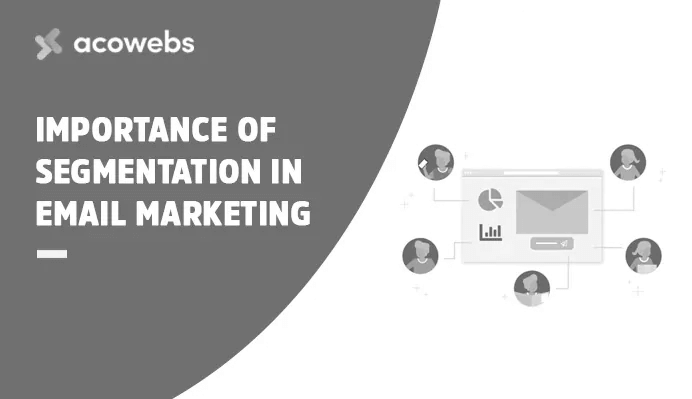
In today’s fast-paced digital world, consumers receive an overwhelming number of emails daily. Without proper segmentation, businesses risk sending irrelevant messages, leading to low engagement and high unsubscribe rates. This is where email segmentation ideas come into play, helping marketers tailor their messaging for better results.
1. Higher Engagement Rates
Segmented emails achieve significantly better open and click-through rates because they are personalized to the recipient’s interests, behavior, and demographics. When subscribers receive content that resonates with them, they are more likely to engage with the brand.
2. Increased Conversion Rates
A well-segmented email list ensures that subscribers receive offers and recommendations relevant to their needs. For instance, an online store suggesting complementary products based on a customer’s past purchases is more likely to drive conversions. Implementing effective email segmentation ideas can improve targeting, leading to higher sales.
3. Reduced Unsubscribes and Spam Complaints
When people receive irrelevant emails, they tend to unsubscribe or mark them as spam. Segmentation ensures that subscribers receive content that aligns with their preferences, reducing the likelihood of opt-outs.
4. Stronger Customer Relationships
Personalized emails foster trust and loyalty by showing that a brand understands its audience’s needs. Using advanced email segmentation ideas, businesses can nurture long-term customer relationships and encourage repeat purchases.
By leveraging email segmentation ideas, businesses can create more meaningful, targeted campaigns that drive engagement, conversions, and customer retention. Segmentation is not just a best practice, it’s a necessity for successful email marketing.
Saufter: The Best AI-Based Digital Marketing Tool

In the fast-paced world of digital marketing, Saufter AI stands out as the ultimate solution for businesses looking to optimize their email campaigns with cutting-edge artificial intelligence. Whether you run a SaaS platform, an e-commerce store, or any other online business, Saufter AI empowers you with data-driven insights and automation to enhance engagement and conversions.
Key Features
- Competitor Email Tracking: Automatically monitors and analyzes your competitors’ email campaigns, helping you stay ahead of the curve.
- User Behavior Analysis: Studies user interactions on your website and tracks their journey to generate targeted campaign suggestions.
- Personalized Email Campaigns: AI-driven personalization enhances email deliverability and engagement, ensuring your messages reach the right audience.
Cohort-Based Suggestions: Segment users based on their engagement levels and behaviors to optimize campaign effectiveness.
Conclusion
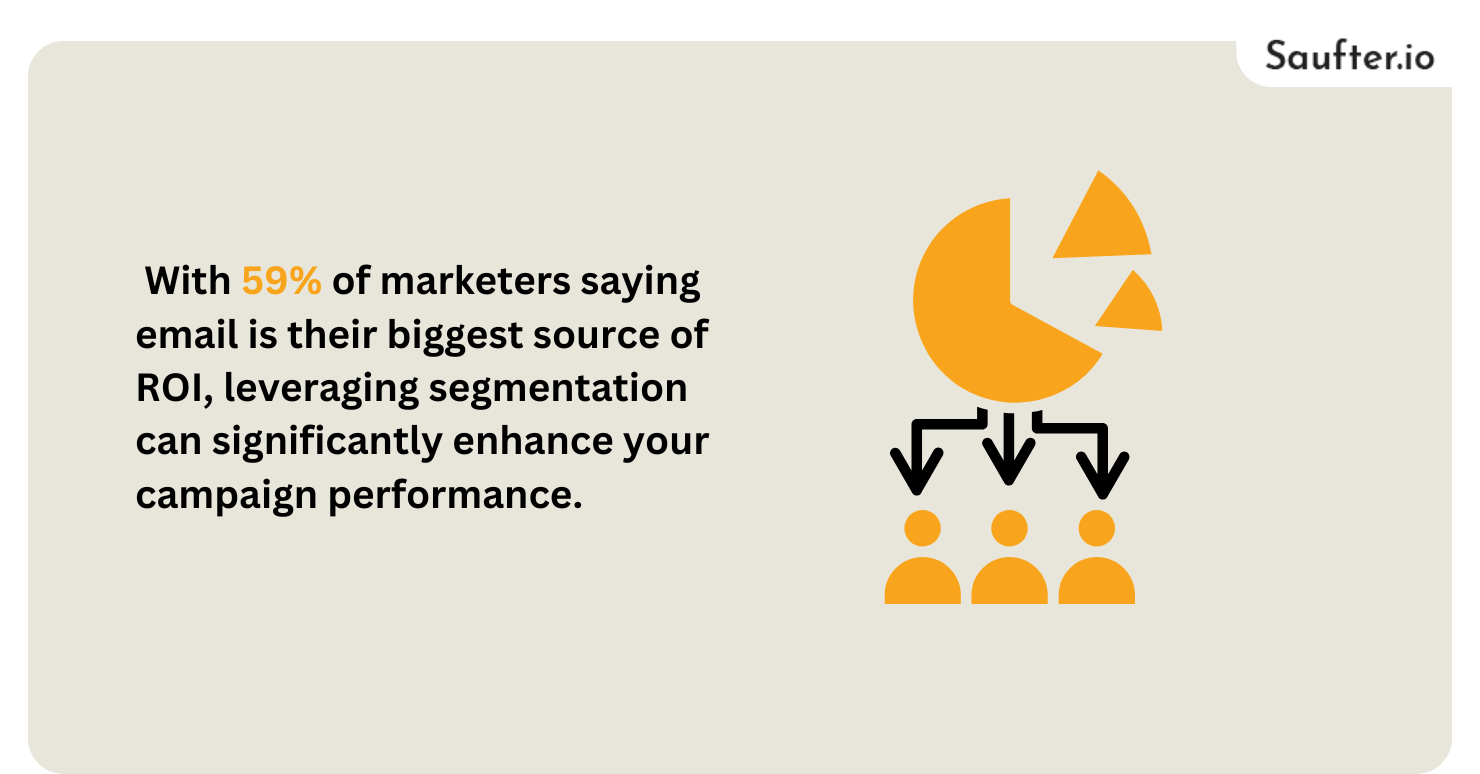
Segmentation in email marketing is no longer a luxury, it’s a necessity. With 59% of marketers saying email is their biggest source of ROI, leveraging segmentation can significantly enhance your campaign performance.
By dividing your audience into smaller, more targeted groups, you can deliver personalized, relevant content that resonates with recipients. This not only improves engagement and conversion rates but also fosters stronger customer relationships.
As the statistics show, segmented campaigns outperform non-segmented ones by a significant margin. Whether you’re a small business or a large enterprise, implementing segmentation in email marketing can help you achieve your goals and maximize your ROI.
Start by collecting relevant data, testing your campaigns, and monitoring performance metrics. With the right strategies and tools, you can unlock the full potential of segmentation in email marketing and take your campaigns to the next level.
